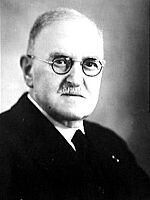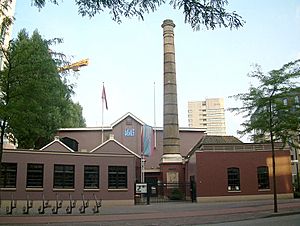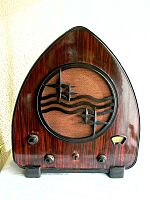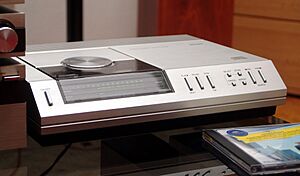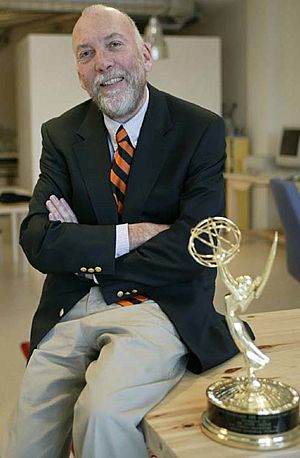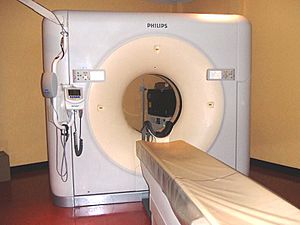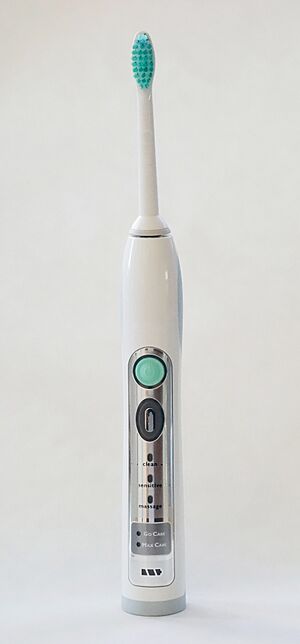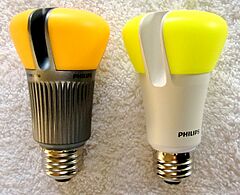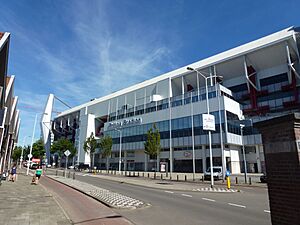Philips facts for kids
 |
|

Headquarters in Amsterdam, 2009
|
|
|
Formerly
|
|
|---|---|
| Public | |
| Traded as |
|
| Industry | Health technology |
| Founded | 15 May 1891 in Eindhoven, Netherlands |
| Founders | Gerard and Anton Philips |
| Headquarters | Amsterdam, Netherlands |
|
Area served
|
Worldwide |
|
Key people
|
|
| Products |
|
| Revenue | |
|
Operating income
|
|
| Total assets | |
| Total equity | |
|
Number of employees
|
68,419 (2024) |
Koninklijke Philips N.V. (which means Royal Philips), known simply as Philips, is a famous Dutch company. It started in 1891 in the city of Eindhoven. Today, its main office is in Amsterdam. The company is known for making health technology products. In the past, it was a giant in consumer electronics.
Philips was started by Gerard Philips and his father, Frederik. Their first products were light bulbs. Over the 20th century, Philips grew into one of the world's biggest electronics companies. It made everything from kitchen gadgets and electric shavers to TVs. Philips even invented the cassette tape and the compact disc (CD).
In the 1990s and 2000s, the company faced tough competition. This led Philips to change its focus. It sold its lighting and consumer electronics businesses. Now, Philips is mainly a healthcare company.
As of 2024, Philips has three main parts. One part makes medical scanners like MRI and CT scanners. Another part makes patient monitors and breathing devices. The third part makes personal items like electric shavers and Sonicare electric toothbrushes. Philips also founded the famous sports club PSV Eindhoven in 1913.
History
The Philips Company was founded in 1891 by Gerard Philips and his father, Frederik. Frederik was a banker and helped pay for an empty factory in Eindhoven. In 1892, they started making light bulbs with carbon filaments. This first factory is now a museum.
The first few years were hard, and the company almost went out of business. In 1895, Gerard's younger brother, Anton Philips, joined the company. Anton was a great salesman and had many smart business ideas. With his help, the family business grew quickly. By 1912, they had officially formed the company Philips Gloeilampenfabrieken N.V. (Philips Lightbulb Factories Ltd.).
New Inventions and Growth
In the 1920s, Philips began making other products, like vacuum tubes for radios. On March 11, 1927, Philips launched its own shortwave radio station, PCJJ. This station broadcast programs around the world. One famous show, Happy Station, became the world's longest-running shortwave program.
In the 1930s, Philips introduced a popular radio called the "Chapel." It was special because it had a loudspeaker built right into its wooden case. The company also introduced its first electric shaver, the Philishave, in 1939. The Philishave is still sold today.
Philips During World War II
When the German army invaded the Netherlands in 1940, the Philips family leaders fled to the United States. They took a large amount of the company's money with them. From the U.S., they were able to keep the company running during the war.
Frits Philips, the son of Anton, was the only family member who stayed in the Netherlands. He saved the lives of 382 Jewish workers by telling the Nazis they were essential for his factory. For his bravery, he was later honored as one of the "Righteous Among the Nations" by Yad Vashem.
Post-War Innovations
After the war, Philips returned to the Netherlands. The company started selling television sets in 1949. In 1963, Philips invented the compact audio cassette. It was a huge success. At first, cassettes were used for recording speech. But as the sound quality got better, they became a popular way to listen to music, along with vinyl records.
Philips also created the first portable radio and cassette recorder, which we now call a boombox.
In 1972, Philips launched the world's first home videocassette recorder (VCR). Later, Philips worked with Sony to create the compact disc (CD) in 1982. This invention changed how people listen to music. The technology from CDs later led to DVDs and Blu-ray discs.
Changes and Challenges
In the 1980s and 1990s, Philips faced strong competition from other electronics companies. The company began to lose money. To survive, Philips had to make big changes. It sold off some of its businesses, like the one that made computers.
In 1997, the company moved its headquarters from Eindhoven to Amsterdam. It also changed its name to Koninklijke Philips Electronics N.V. In 2013, it shortened the name to Royal Philips N.V.
Focusing on Healthcare
Starting around 2011, Philips began a major change. The company decided to shift its focus from electronics to healthcare technology. This new strategy helped the company become successful again.
Philips sold its audio and video businesses. In 2016, it also separated its famous lighting division into a new company called Signify. Signify still makes and sells Philips-branded light bulbs, like the Philips Hue smart lights.
To grow its healthcare business, Philips bought several medical companies. These included companies that make devices to treat heart disease and monitor patients. Today, Philips is a leader in medical imaging, patient care, and personal health products.
Corporate Affairs
Philips is a public company, which means people can buy shares of it on the stock exchange. Its main listing is on the Euronext Amsterdam stock exchange.
Over the years, Philips has had many leaders. The first CEO was the founder, Gerard Philips. The current CEO is Roy Jakobs, who took the role in 2022.
Throughout its history, Philips has bought many other companies to help it grow. Some of these include Magnavox, Sonicare, and Respironics. It also sold parts of its business, like its music division, PolyGram, and its semiconductor division, which became NXP Semiconductors.
Products
Philips makes a wide range of products, mostly focused on health and well-being.
Healthcare Products
Philips is a major producer of medical equipment used in hospitals.
- Imaging Systems: These include CT scanners, MRI machines, and X-ray equipment that help doctors see inside the body.
- Patient Monitoring: Devices that track a patient's heart rate, blood pressure, and other vital signs.
- Defibrillators: Machines used to restart someone's heart during a medical emergency.
- Ultrasound: Equipment that uses sound waves to create images of organs and babies in the womb.
Personal Health Products
These are products people use at home to take care of themselves.
- Shavers and Grooming: Electric shavers for men and beauty appliances for women.
- Oral Healthcare: The popular Sonicare brand of electric toothbrushes.
- Mother and Child Care: Products for babies and new mothers under the Philips Avent brand.
Former Products
For many years, Philips was famous for its consumer electronics.
- Audio and Visual: TVs, radios, VCRs, and headphones. Philips invented the cassette tape and co-invented the CD.
- Lighting: Philips was one of the world's biggest makers of light bulbs for homes, offices, and cars. This business is now part of the company Signify.
Sponsorships
Philips has a long history of sponsoring sports. In 1913, it started its own sports club, which is now famous as the PSV Eindhoven football team. The team's home stadium in Eindhoven is named the Philips Stadium.
The company has also sponsored other teams and events around the world. For many years, it sponsored the Atlanta Hawks basketball team's arena in Atlanta, which was called the Philips Arena. In 2024, Philips became a sponsor for the La Liga football team FC Barcelona.
Environmental Record
Philips has taken steps to be more environmentally friendly. The company runs an "EcoVision" program to make its products more energy-efficient. Products that meet these standards get a special Philips Green Logo.
In 2011, Philips won a $10 million prize from the U.S. Department of Energy. The prize was for creating a highly efficient LED lightbulb to replace the old 60-watt incandescent bulbs.
However, in the past, Philips was part of a group of companies called the Phoebus cartel in 1925. This group agreed to make light bulbs that would not last as long, so that people would have to buy new ones more often. This is known as planned obsolescence.
Images for kids
See also
 In Spanish: Philips para niños
In Spanish: Philips para niños


